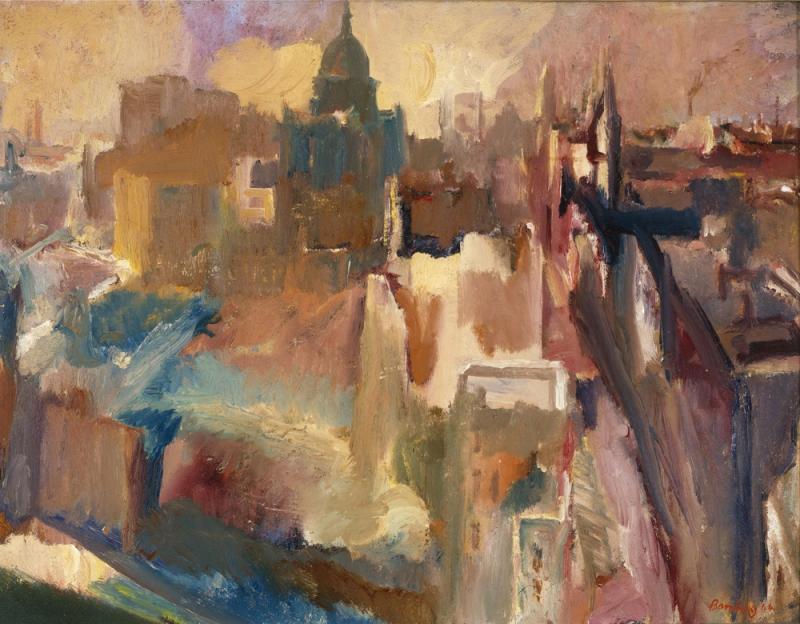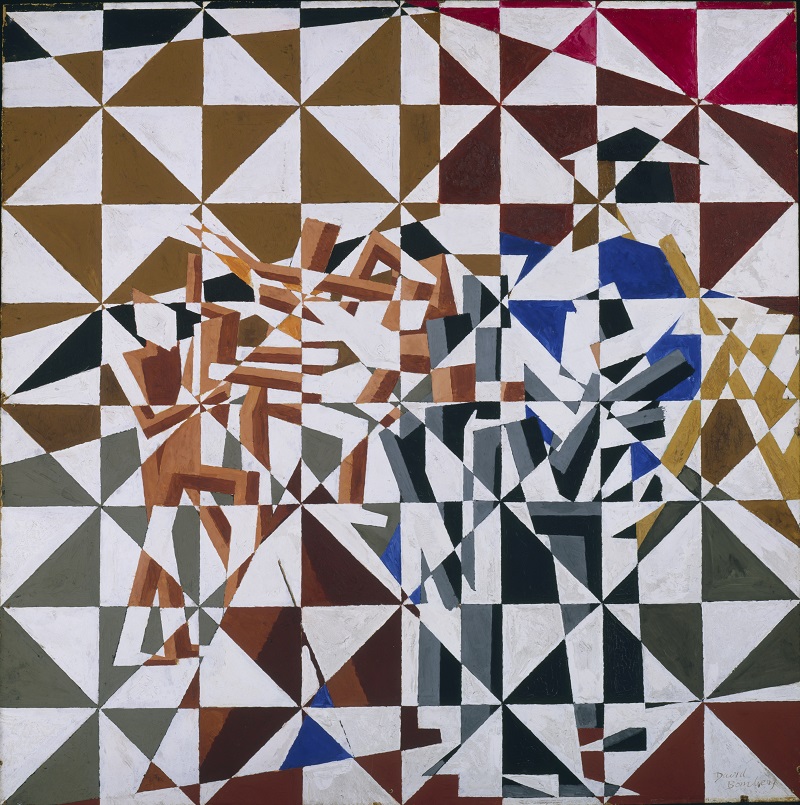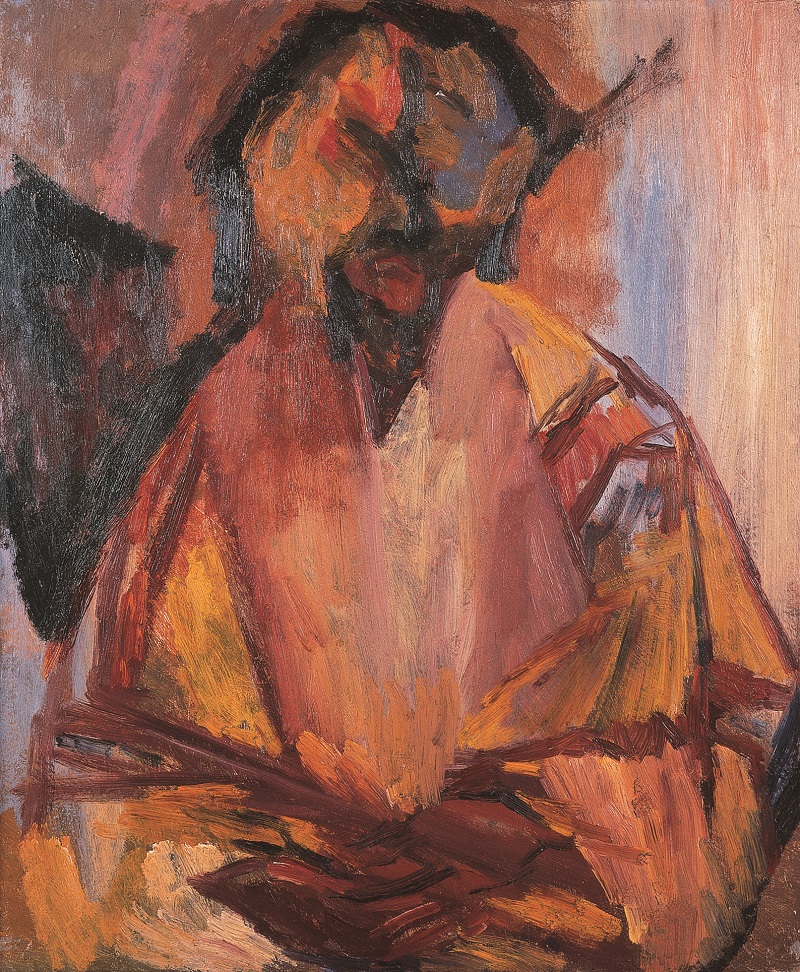David Bomberg, Pallant House Gallery, Chichester review - a reputation restored | reviews, news & interviews
David Bomberg, Pallant House Gallery, Chichester review - a reputation restored
David Bomberg, Pallant House Gallery, Chichester review - a reputation restored
Light shed on neglected British artist by a timely touring exhibition

During his time at the Slade David Bomberg — the subject of a major new retrospective at Pallant House Gallery — was described as a "disturbing influence". The fifth son of Polish-Jewish parents who fled the pogroms, he grew up at the turn of the 20th century in the East End of London where neighbours lived on top of one another and space was scarce.
There was always something of the rebel about him. Living in Jerusalem between the wars he had himself smuggled into the Armenian church to witness and paint the ceremony of the Washing of the Feet during Easter week, and towards the close of World War Two, during which he served as a firewatcher, he scaled St Mary-le-Bow on Cheapside to paint a striking portrait of London, bedraggled, smoke-dour and unbowed.
The exhibition is carefully curated to provide a chronological overview of Bomberg’s output. His style varied enormously over his lifetime and cohesion is achieved through a series of self-portraits pulling us back to the artist himself, his style and present sense of himself (pictured below, Last Self-Portrait, 1956 © The Wilson Family). From confident young agitant to ageing master, we follow the effect of his painterly revelations — the extraordinary Barges, 1919, the result of painting outdoors, and the experience of sunlight of the Middle East and Spain breathing colour into his palette in the third room.
 We also see the grip of his disillusionments and failures — of which there were many. Pairings of paintings run through the exhibition and in At the Window, 1919, we see clearly how a reworking of the naturalistic Woman Looking Through a Window, 1911, closes down perspective and encloses the sitter — an apt metaphor for his experience of the war. Sappers at Work, 1918-19, In the Hold, 1913-14, and The Mud Bath, 1914, are notable absences from a particularly fruitful period, but preparatory studies for each are on display charting the artistic process behind these bold, well-known works.
We also see the grip of his disillusionments and failures — of which there were many. Pairings of paintings run through the exhibition and in At the Window, 1919, we see clearly how a reworking of the naturalistic Woman Looking Through a Window, 1911, closes down perspective and encloses the sitter — an apt metaphor for his experience of the war. Sappers at Work, 1918-19, In the Hold, 1913-14, and The Mud Bath, 1914, are notable absences from a particularly fruitful period, but preparatory studies for each are on display charting the artistic process behind these bold, well-known works.
Bomberg died at St Thomas’s in London after being moved from his beloved Ronda where he had attempted to set up a painting school. His figurative style and teaching influenced a new generation of artists, among them Frank Auerbach whose paintings hang in adjacent rooms, but he died in relative obscurity. Nevertheless, his Times obituary hailed his independence of vision and within a year the Arts Council had organised a retrospective. Having since fallen out of favour, this boy from Whitechapel is restored to his rightful place in the history of British art by a timely exhibition.
- Bomberg is at Pallant House Gallery, Chichester (curated by the Ben Uri Gallery and Museum) until 4 February 2018, then the Laing Art Gallery, Newcastle, from 17 February to 27 May
- More visual art reviews on theartsdesk
The future of Arts Journalism
You can stop theartsdesk.com closing!
We urgently need financing to survive. Our fundraising drive has thus far raised £49,000 but we need to reach £100,000 or we will be forced to close. Please contribute here: https://gofund.me/c3f6033d
And if you can forward this information to anyone who might assist, we’d be grateful.

Subscribe to theartsdesk.com
Thank you for continuing to read our work on theartsdesk.com. For unlimited access to every article in its entirety, including our archive of more than 15,000 pieces, we're asking for £5 per month or £40 per year. We feel it's a very good deal, and hope you do too.
To take a subscription now simply click here.
And if you're looking for that extra gift for a friend or family member, why not treat them to a theartsdesk.com gift subscription?
more Visual arts
 'We are bowled over!' Thank you for your messages of love and support
Much-appreciated words of commendation from readers and the cultural community
'We are bowled over!' Thank you for your messages of love and support
Much-appreciated words of commendation from readers and the cultural community
 Photo Oxford 2025 review - photography all over the town
At last, a UK festival that takes photography seriously
Photo Oxford 2025 review - photography all over the town
At last, a UK festival that takes photography seriously
![SEX MONEY RACE RELIGION [2016] by Gilbert and George. Installation shot of Gilbert & George 21ST CENTURY PICTURES Hayward Gallery](https://theartsdesk.com/sites/default/files/styles/thumbnail/public/mastimages/Gilbert%20%26%20George_%2021ST%20CENTURY%20PICTURES.%20SEX%20MONEY%20RACE%20RELIGION%20%5B2016%5D.%20Photo_%20Mark%20Blower.%20Courtesy%20of%20the%20Gilbert%20%26%20George%20and%20the%20Hayward%20Gallery._0.jpg?itok=7tVsLyR-) Gilbert & George, 21st Century Pictures, Hayward Gallery review - brash, bright and not so beautiful
The couple's coloured photomontages shout louder than ever, causing sensory overload
Gilbert & George, 21st Century Pictures, Hayward Gallery review - brash, bright and not so beautiful
The couple's coloured photomontages shout louder than ever, causing sensory overload
 Lee Miller, Tate Britain review - an extraordinary career that remains an enigma
Fashion photographer, artist or war reporter; will the real Lee Miller please step forward?
Lee Miller, Tate Britain review - an extraordinary career that remains an enigma
Fashion photographer, artist or war reporter; will the real Lee Miller please step forward?
 Kerry James Marshall: The Histories, Royal Academy review - a triumphant celebration of blackness
Room after room of glorious paintings
Kerry James Marshall: The Histories, Royal Academy review - a triumphant celebration of blackness
Room after room of glorious paintings
 Folkestone Triennial 2025 - landscape, seascape, art lovers' escape
Locally rooted festival brings home many but not all global concerns
Folkestone Triennial 2025 - landscape, seascape, art lovers' escape
Locally rooted festival brings home many but not all global concerns
 Sir Brian Clarke (1953-2025) - a personal tribute
Remembering an artist with a gift for the transcendent
Sir Brian Clarke (1953-2025) - a personal tribute
Remembering an artist with a gift for the transcendent
 Emily Kam Kngwarray, Tate Modern review - glimpses of another world
Pictures that are an affirmation of belonging
Emily Kam Kngwarray, Tate Modern review - glimpses of another world
Pictures that are an affirmation of belonging
 Kiefer / Van Gogh, Royal Academy review - a pairing of opposites
Small scale intensity meets large scale melodrama
Kiefer / Van Gogh, Royal Academy review - a pairing of opposites
Small scale intensity meets large scale melodrama
 Jenny Saville: The Anatomy of Painting, National Portrait Gallery review - a protégé losing her way
A brilliant painter in search of a worthwhile subject
Jenny Saville: The Anatomy of Painting, National Portrait Gallery review - a protégé losing her way
A brilliant painter in search of a worthwhile subject
 Abstract Erotic, Courtauld Gallery review - sculpture that is sensuous, funny and subversive
Testing the boundaries of good taste, and winning
Abstract Erotic, Courtauld Gallery review - sculpture that is sensuous, funny and subversive
Testing the boundaries of good taste, and winning
 Edward Burra, Tate Britain review - watercolour made mainstream
Social satire with a nasty bite
Edward Burra, Tate Britain review - watercolour made mainstream
Social satire with a nasty bite

Add comment